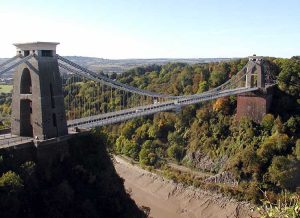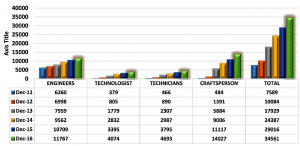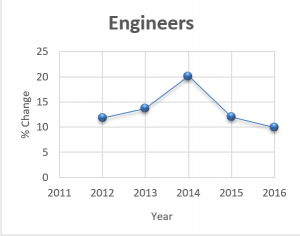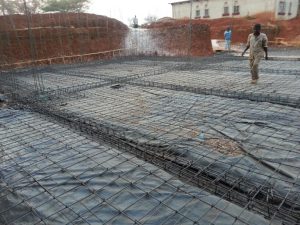By Habeene Habeenzu, Pr Eng.
Why do newly constructed roads fail and yet records of all the material and workmanship quality tests on these projects show that the materials and workmanship had passed quality tests? Why are South African engineering professionals preferred to Zambian engineering professionals? Can Zambian engineering professionals be trusted to undertake complex engineering tasks?
There are many answers and reasons that can be given to these questions. But for now, I would like to discuss one important aspect which is why we need to increase and improve the quality and quantity of technologists, technicians and other engineering professionals who support the engineer. I will generically refer to them as technicians. In a later posting I will discuss the route to professional registration.
The Engineering Team
To begin with we need to understand the concept of the “engineering team” of which technicians are a very import part of. The engineering team comprises the engineer, the engineering technologist, engineering technician and crafts person or artisan. To successfully accomplish an engineering task, a suitably qualified and appropriately experienced engineering team needs to be assembled. Technicians will be required to assist the engineer communicate and implement the engineering solution. Should there be a disconnect in the engineering team, it will usually show in a disconnect between the design and the implementation and will result in substandard engineering work.
The engineer is concerned with the “big picture” of things and as such should be a person who “can comprehend and apply an advanced knowledge of widely applied engineering principles in the solution of complex problems.” [1] He must understand why things are done in a certain way. This requires broad training and mentored practical experience. It is very difficult to take both the big picture view of things and the detailed view. Technicians fill in this role of taking the detailed view. Hence the engineer may design but technicians should make the designs work in the real world.
Technician training does not need to be as broad as that of an engineer as the technician’s work is more task-oriented. It should none the less give the technician deep knowledge in the practical aspects of their work. Good technicians may be more knowledgeable about the practical implementation of engineering tasks than engineers. It follows that three month training courses are not adequate training for technicians to allow them to find their right place in the engineering team. The same effort that is put to train engineers should be applied to train technicians.
Policy Statement 535 – Defining the Civil Engineering Team of the Association of American Engineers (ASCE) notes that Civil engineering (or any engineering for that matter), like other learned professions, consists of a work continuum with varying complexities that is most effectively accomplished by individuals with different ranges of responsibilities, qualifications, and work experience.
A Very Brief History of the Engineering Team
Encyclopaedia Britannica says the term engineer is derived from the Latin root, ingenerare, which means “to create.” It goes on to say “The early English verb engine meant “to contrive.” Thus the engines of war were devices such as catapults, floating bridges, and assault towers; their designer was the “engine-er,” or military engineer. The counterpart of the military engineer was the civil engineer, who applied essentially the same knowledge and skills to designing buildings, streets, water supplies, sewage systems, and other projects.”
Interestingly enough, encyclopaedia Britannica puts Imhotep as the first engineer known by name and achievement. He built King Djoser’s Step Pyramid at Saqqara around 2550 BC.


Figure 1: (left) Statuette of Imhotep; (Right) Djoser’s Step Pyramid (Source Wikimedia commons)
Early engineers used simple “empirical methods aided by arithmetic, geometry, and a smattering of physical science” to build remarkable wonders of engineering whose legacy endures today. [2] All these ancient wonders of engineering were the result of team work of the early engineering team. The engineers were required to have a good grasp of mathematics, geometry, and knowledge of available materials and how to maximise their use. These early engineers operated on the limited science available and mostly by trial and error. But above all, crucial to their success was their ability to work in teams. Looking into the organisation of labour to build the pyramids, archaeologist have concluded that ‘…the work was organised along tried and tested lines, designed to reduce the vast workforce and their almost overwhelming task to manageable proportions.’ [3]
With the increase in knowledge of the sciences, the development of calculus, in what may be termed the scientific revolution, from trial and error and training mostly by apprenticeship, engineers now applied the scientific knowledge and increasingly got their training in formal schools. “Civil engineering emerged as a separate discipline in the 18th century” [2] and in 1818 the Institution of Civil Engineers (ICE) was founded. It is the world’s first professional engineering body.
Great engineers of this time such as Islambard Brunel who is said to be “one of the most versatile and audacious engineers of the 19th century” [4], “…could never have achieved all he did without the substantial staff of skilled engineers, draughtsmen and clerks who worked for him.” [5] Brunel built bridges such as the Clifton Suspension Bridge (1864) and the Royal Albert Bridge (1859). He also built Ships, buildings, railways and tunnels.


Figure 2: (left) Clifton Suspension Bridge; (Right) Royal_Albert_Bridge (Source Wikimedia commons)
The industrial revolution brought with it the emergence of mechanical and electrical engineering, while the information age has spawned further branches of engineering such as IT and software engineers. The vast amount of knowledge now available has also transformed the engineering team such that a technologist role has evolved to fill the gap between the engineer and the technicians.
The Engineering Team in Zambia Today
For Engineering in Zambia to progress, we need to ensure that the engineering team is well catered for in terms of training, work experience and job satisfaction. For every engineer there needs to be two or more supporting engineering professionals who are qualified and well-motivated.
Data from EIZ shows a steady increase in membership growth among all categories of engineering professionals. Figure 2 below shows the membership comparative growth by category for the period 31-12-2011 to 31-12-2016.

Figure 3: Membership comparative growth by category for the period 31-12-2011 to 31-12-2016
However when data is viewed as a year on year percentage change, the data gives an interesting insight (See figures 4-7 below).

Figure 4: Percentage Change in Membership Growth for Engineers

Figure 5: Percentage Change in Membership Growth for Technologists

Figure 6: Percentage Change in Membership Growth for Technicians

Figure 7: Percentage Change in Membership Growth for Crafts Persons
What these graphs show is that the membership percentage growth for engineers is steady while for the rest of the engineering professionals membership percentage growth has fallen by alarming levels for both decrease in percentage growth and the rate of decline. We can safely conclude that there is much less motivation for technicians to register which has a direct bearing on the quality of the engineering teams.
What can we do to improve the quantity and quality of Technicians in Zambia?
Firstly we need to ensure that the training of technicians needs to be adequate. The vast amount of knowledge required today means that it has to be more intensive. More importantly it must address what may be termed the “whys and wherefores” of engineering work.
Technicians, should create their own society or strong branch within EIZ. These can take a form such as that of the American Society of Certified Engineering Technicians (ASCET). The ASCET states its mission statement as:
“The American Society of Certified Engineering Technicians provides opportunities for technicians and technologists to magnify their status as vital members of the engineering team.” [6]
Further, the EIZ should update its definitions of other engineering professionals who support the engineer as it is deficient in its current form. For example, the EIZ Act currently defines a technologist as:
“… an individual who has pursued a programme of study recognised by the Institution and has been awarded a Diploma in Technology or Engineering by a legally recognised qualification awarding body upon successful completion.” [7]
This definition is insufficient and does not recognise adequately the importance of the engineering technologist. In contrast, the ASCE defines the technologist as:
“Civil Engineering Technologist (CE Technologist) – A person who exerts a high level of judgment in the performance of engineering work, while working under the direct control and personal supervision of a CE Professional. A person initially obtains status as a CE Technologist through the completion of requisite formal education and experience and may include examination and other requirements as specified by a credentialing body. A person working as a CE Technologist can comprehend and apply knowledge of engineering principles in the solution of broadly defined problems.”
This comprehensive definition allows the ASCE to give better support to the technicians as can be seen from the Policy Statement 535 where it says “To effectively provide civil engineering services, the proper use of the entire civil engineering project team will become increasingly important in the future. ASCE believes it is essential to improve the utilization, recognition and support of technologists and technicians within the civil engineering project team.”
Conclusions
Technologists, technicians and craftsmen need to be life long careers and should be remunerated for what they bring to the team. It is important that they are well motivated. Graduate engineers should not earn more than well experienced technicians.
Engineering work is a continuum. No stage should be neglected. We should allow every member of the engineering team to play their roles and will allow each component to develop itself more fully. This way, with the right engineering team in place, the performance of newly constructed roads will be in harmony with construction records. Further with task oriented work safely handled by suitably qualified and experienced supporting engineering professionals, engineers will be able to concentrate on sharpening their skills for complex engineering tasks. An engineer should not design and spend more time producing AutoCAD drawings. This should be left to technicians who will become experts and so perform these tasks efficiently and continue to improve them over time.
References
| [1] | A. S. o. C. E. (ASCE), “Policy Statement 535 – Defining the Civil Engineering Team,” 2014. |
| [2] | R. J. Smith, 15 August 2017. [Online]. Available: https://www.britannica.com/technology/engineering. |
| [3] | J. Tyldesley, “Pyramid-builders,” 15 August 2017. [Online]. Available: http://www.bbc.co.uk/history/ancient/egyptians/pyramid_builders_01.shtml. |
| [4] | “History, Isambard Kingdom Brunel,” 15 08 2017. [Online]. Available: http://www.bbc.co.uk/history/historic_figures/brunel_kingdom_isambard.shtml. |
| [5] | S. Brindle, Brunel The Man Who Built the World, London: Phoenix, 2005. |
| [6] | ASCET, 15 August 2017. [Online]. Available: https://www.ascet.org/AboutUs. |
| [7] | The Engineering Institution of Zambia Act, 2010. |


